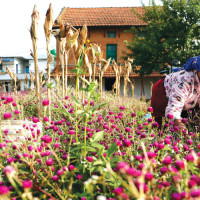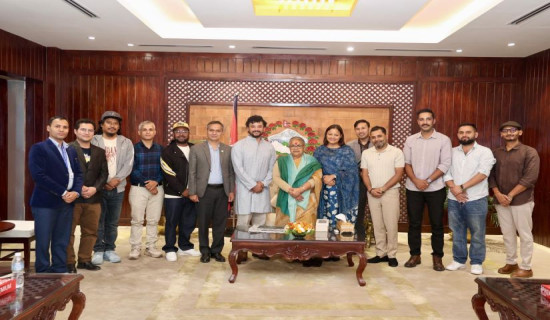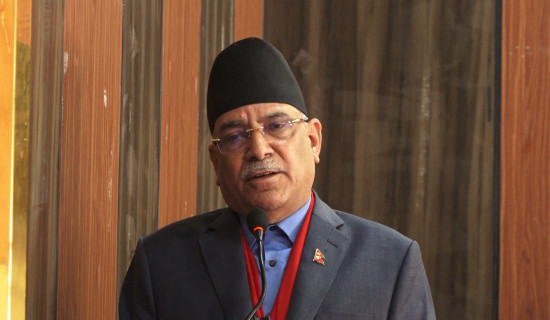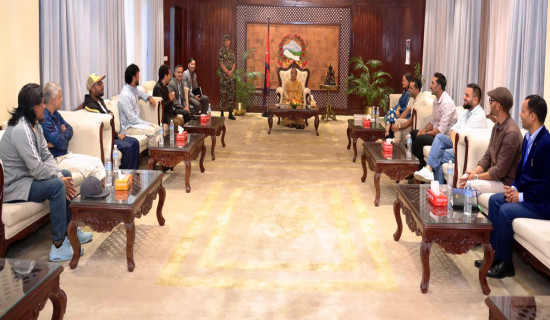- Thursday, 23 October 2025
Rejoice Invincible Power Of Goddess Durga
The Dashain festival serves as a commemoration of the indomitable power embodied by Goddess Durga. She represents feminine energy, shielding her devotees from various forms of suppression, domination, and oppression. According to Hindu tradition, she is perceived as the divine amalgamation of the goddesses Kali, Laxmi, and Saraswoti, brought into existence by the divine entity Vishnu. Goddess Durga is considered the protector of humanity against malevolent forces, symbolised by demons such as Mahishasur.
The belief holds that the recitation of Durga Chalisa during the ten-day Dashain festival, infused with complete devotion, can dispel obstacles, pains, and sufferings from the lives of the devotees. Worshipping Goddess Durga conveys a moral lesson that, regardless of how potent an evil force may be, its defeat is inevitable. The act of worship becomes a symbolic expression of courage, instilling in us the resolve to stand fearlessly during times of adversity, as it is believed that every problem's evil fate is destined to end. This conviction was exemplified when Goddess Durga vanquished the demon Mahishasura.
Goddess Durga’s appearance and the weapons she carries have an influential message for us. Chakra, for example, represents the sense of being responsible and righteous. We should make this life meaningful by accomplishing our duties and responsibilities with a sense of integrity. The sword represents the annihilation of immorality. We should always be on the path of morality and do our tasks happily with a sense of self-contentment. The lotus flower symbolises detachedness with a sense of perfection. We should spread love to others with a sense of humanity, humility, love, and compassion without being distracted by the dirty outside world.
Like a lotus flower, we should always shine and love without being disturbed by the external world. It may take us to the world of ecstasy, filled with love and bliss. Trishul is a symbol of strength and courage. We should have the courage to eliminate our negative emotions, such as anger, jealousy, lust, and greed, to connect with the highest source of divinity and light, and to solve the riddles of our lives.
The way she appeared in a red sari symbolised her passion for seeking truth and justice. The colour red signifies taking immediate action against any cruelties or social absurdities. Her fourth lower hand symbolises blessings and a sense of giving forgiveness to oneself and others. We should develop the habit of forgiving ourselves to experience inner peace and bliss. Similarly, we should also forgive others, as this provides us with a space to remain connected to the divine realm.
According to Hindu tradition, Goddess Durga maintains mainly three traits of mother nature: Satya, Rajas, and Tamas. Satya symbolises serenity and equilibrium that lie in her Maha Saraswoti form; Rajas symbolises activity and dynamism that lie in her Maha Laxmi form; and Tamas symbolises the power of destruction that lies in her Maha Kali form. All this feminine power has tremendous potential to achieve victory over evil or wickedness. Worshipping Goddess Durga with a sense of love and meditation is an attitudinal attainment for self-realization. This is the first step in the process of attaining self-realisation.
Nine forms of Goddess Durga are worshipped during the Dashain festival. The victory of Goddess Durga over the demon Mahishasura is celebrated as a nine-day-long festival known as Navaratri. For Hindus, Goddess Durga is a very special deity, and she appears in nine different forms, each of which is characterised by unique powers and qualities. Together, these nine manifestations are called Navadurga. The victory of Goddess Durga over the demon Mahishasura is celebrated as a nine-day-long festival known as Navaratri.
Shailaputri, also known as Sati Bhavani, Parvati, or Hemavati, is Durga's primary manifestation. On the first day, this form is adored. It is believed that she bestows beauty, love, and peace upon all who follow her. Hindus offer Brahmacharini their worship on the second day of Navaratri. It is believed that she bestows liberation on her followers.
Chandraghanta is the third incarnation of Durga. She represents happiness and tranquilly in life. She stands ready at all times to confront evil coming from any angle and shields her followers from all perils. The fourth incarnation of the goddess Durga is known as Kushmanda. Her name refers to the universe's founder. It is believed and accepted that she is the one who illuminated the vastly dark universe.
She is riding a lion, which represents power and fortitude in the face of adversity. Skandamata is the fifth incarnation of the goddess Durga. Kartikeya's mother, she is. Hindus who are devoted and committed to advancing humanity are granted this. Katayani is worshipped on the sixth day of the Navaratri festival. Darkness and harmful forces cannot hide from the brilliant light she exudes from her body. She is said to be able to give her followers a calm disposition. She also always travels atop a lion, ready to take on evil.
On the seventh day of Navaratri, Hindus celebrate Kalaratri. She is a scary deity with four arms, three eyes, and frowzy hair. She is recognised for being a protector against all phobias.
Hindus observe Kalaratri on the seventh day of Navaratri. She has four arms, three eyes, and frowzy hair, making her a terrifying-looking deity. She is revered as a defender against all phobias. On the eighth day of Navaratri, Mahagauri is worshipped. Hindus believe that by offering her sincere devotion, all misdeeds from the past, present, and future will be forgiven. She bestows inner tranquilly on her followers. Siddhidatri is Durga's last incarnation. Her disciples are said to receive wisdom and understanding from her.
The tenth day of the Navadurga celebration is known as Vijaya Dashain. It marks the festival's conclusion and is frequently seen as a triumph of good over evil. This day also commemorates the demon king Mahishasur's demise, who was put to death by the goddess Durga. This day also commemorates the end of the Pandavas' exile and their victory over the Kauravas in the Mahabharata. After spending 10 days at her parents' residence, or on earth, Goddess Durga returned to her home of Kailash on this day, according to myth. Hindus have the view that she travels annually to her ancestral home (Earth) to end the suffering of her faithful worshippers.
The most chanted mantra is "Sarva mangala mangalye Sive Sarvartha Sadhike Sarnanye Trayambike Gauri Narayani Namostute". To bless surrendered souls, this mantra reflects the purest and holiest form of Goddess Durga.
(The writer is a lecturer of English at Global College of Management.)












-original-thumb.jpg)



